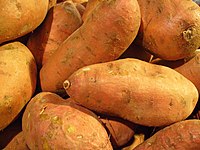
Photo from wikipedia
Sweet potato (Ipomoea batatas L.) cultivation in Turkey is concentrated in one province situated in Mediterranean region only, which would not fulfill the domestic needs of the country soon. Therefore,… Click to show full abstract
Sweet potato (Ipomoea batatas L.) cultivation in Turkey is concentrated in one province situated in Mediterranean region only, which would not fulfill the domestic needs of the country soon. Therefore, cultivation of the crop in other provinces/climatic regions should be initiated to fulfill the domestic needs. The cultivation in other provinces requires thorough assessment of yield and quality traits of target crop. Therefore, yield and quality characteristics of four sweet potato genotypes (i.e., ‘Hatay Kırmızısı’, ‘Hatay Yerlisi’, ‘Havuc’ and ‘Kalem’) were assessed in the current study in Kazova and Niksar counties of Tokat province of the country having middle Black Sea climate in field experiments during 2018 and 2019. The cuttings of the genotypes were planted in Niksar during the second fortnight of April and first week of May in Kazova. The planting density was kept 90 × 45 cm. Data relating to number of storage roots, storage root weight, storage root yield per hill and storage root yield per hectare were recorded. Furthermore, quality traits, including dry matter ratio (%), protein ratio (%) and antioxidant ratio (%) of storage roots were also determined. The highest total storage root yield was recorded for ‘Havuc’ genotype during both years and locations, followed by ‘Hatay Yerlisi’ and ‘Hatay Kırmızısı’ genotypes. Overall, storage root yield (60.06 and 62.40 tons ha-1 during first and second year) recorded for the experiment at Niksar was higher than the storage root yield recorded for Kazova experiment (53.50 and 52.84 tons ha-1 during first and second year, respectively). The highest dry matter was produced by ‘Kalem’ and ‘Hatay Yerlisi’ genotypes during both years and at both locations, followed by ‘Hatay Kırmızısı’ and ‘Havuc’ genotypes. The storage roots of the tested genotypes accumulated higher dry matter at Kazova during both years. The highest protein content was obtained from the ‘Kalem’ genotype, and the protein contents of the ‘Hatay Yerlisi’ and ‘Hatay Kırmızısı’ genotypes were close to the ‘Kalem’ genotype. The results indicated that tested genotypes can successfully be cultivated in middle Black Sea climate. Therefore, production of sweet potato can be initiated in the future to meet the domestic needs for sweet potato in the country.
Journal Title: PLoS ONE
Year Published: 2021
Link to full text (if available)
Share on Social Media: Sign Up to like & get
recommendations!